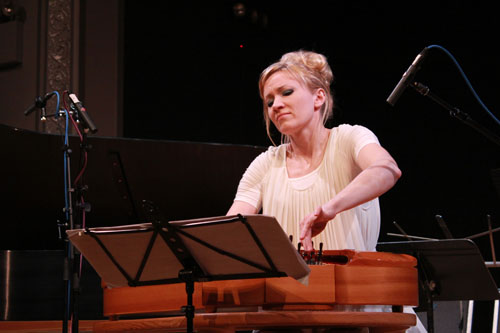 United States MATA Festival 2012, Concert III, “Signs and Signals”: Soloists, Roulette, New York City, 20.4.2012 (DS)
United States MATA Festival 2012, Concert III, “Signs and Signals”: Soloists, Roulette, New York City, 20.4.2012 (DS)
David Coll: Position, Influence
Jacob Cooper: Triptych III
Iván Ferrer-Orozco: Traces IV: Anamnesis
Eric Wubbels: Viola Quartet
Alex Freeman: Magnolia
Francesco Filidei: Ballata
Young composers, more than others, are often starting on a journey to communicate a new concept, emotion, or aesthetic to their listeners. As the listeners, we must meet them halfway, doing our best to acknowledge and interpret the signs they send. But a sign or a signal is meaningless without a receiver and an interpreter. At the final performance of the 2012 MATA Festival at Roulette in Brooklyn, six emerging composers put forth new signs, filling them with meaning, and leaving the audience with new aural possibilities to consider.
David Coll’s Position, Influence, based on a 1968 speech by Charles De Gaulle, directly confronts the issue of communication. Soprano Mellissa Hughes tries to express herself standing at a lectern while hooked up to a system of electronics and metal sheets, which resonate according to the myriad sounds (high-pitched vibrato, spoken words, melodic fragments, and grunts or sighs) emanating from her talented thorax. The frustration and desires inherent in communication were, ironically, communicated powerfully by Coll’s composition—the very issues that normally inhibit mutual understanding came through clearly.
More and more composers are bridging the communication gap with the introduction of video, adding another dimension to their dissemination of signage. Jacob Cooper’s Triptych III used pre-existing footage from Puccini’s La Bohème broken into detailed looped repetitions (or with extreme close-ups or distant views of the stage setting), fragmenting our experience of something well known, or making it unattainable. Iván Ferrer-Orozco’s Traces IV: Anamnesis used a new film, created by Julio Durango, of a Yamaha player piano set against a live pianist—here Kathleen Supové—creating a duality between the performer and the memory of her own playing. To the listener, the work evolves as an interchange, which at first seems playfully improvisational, but soon develops into a complex pre-determined chase between the live instrumentalist and the recording.
Of the six works, Eric Wubbels’ was set in the most common form—a quartet—but the instrumental combination was as daring as its title, Viola Quartet, attests. In the complex possibilities of timbre and thematic material, the relationship to the listener might have gotten lost—the violas seemingly searching for meaning between themselves. For the listener, it was easy to be submerged in the density of musical layers with no sense of exit strategy.

Lastly, two composers explored the possibilities of unusual instruments. Alex Freeman’s Magnolia is composed for the Finnish kantele, a 38-string zither-family instrument, and MATA brought Eva Alkula from Finland to perform it. The instrument’s bell-like sounds combined with Freeman’s exploration of swooning octave slides in a sensually delicate work—a peaceful, dreamy aura devised from a surreal landscape of harpsichord-like textures, slide guitar reminiscences, seductive Siren calls, and folkloric-turned-jazz memories. Francesco Filidei took a different position in instrumental exploration; he looked for textural possibilities in everyday objects, putting an oboist on double duty with bubble wrap and giving a bassoonist a twirling wind contraption in his piece Ballata. With chamber-group intimacy, and a mix of traditional and non-traditional instruments, Ensemble Signal communicated Filidei’s ethereal chromatic mood.
Daniele Sahr
